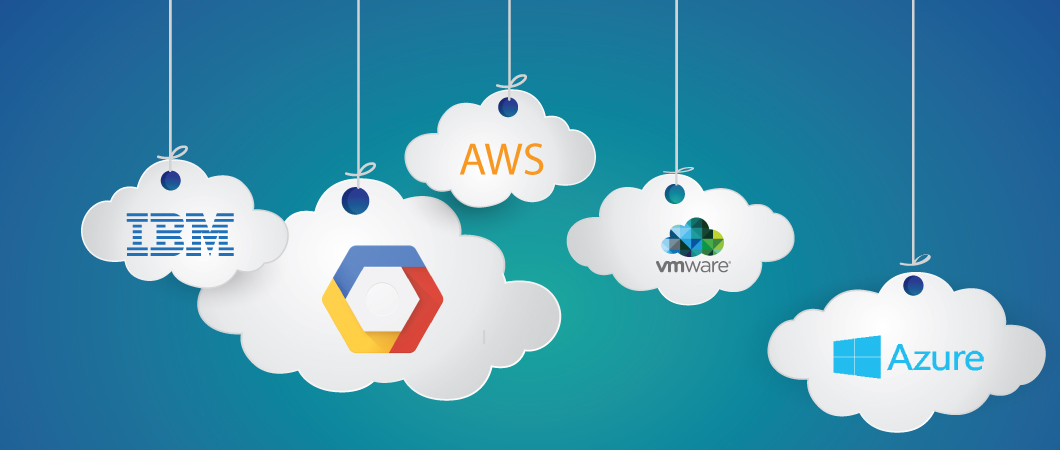RightScale’s 2015 State of the Cloud report shows that more than 93% of businesses are leveraging cloud technology in one form or the other. This report further showed that amongst the 930 surveyed IT companies, approximately 88% were using the public cloud, 63% were using the private cloud and 82% were using hybrid cloud technology. Clearly, the cloud has firmly cemented its place in the enterprise.
Businesses are now further refining their cloud strategies giving rise to the multi-cloud. In a previous blog, we had spoken of why organizations are leaning towards the multi-cloud and how adopting this was giving them more flexibility with their cloud solutions. While adopting a multi-cloud strategy has its advantages, enterprises need to be aware of a certain set of challenges too. They have to address them with certainty in order to ensure that their multi-cloud efforts deliver on the promise of improved IT performance, scalability, interoperability and higher productivity. In this blog, we take a look at some of the challenges of adopting a multi-cloud strategy.
Resource Constraints
Managing a mixed deployment of the private and public cloud along with on-premise solutions needs excellent infrastructure and resource expertise…something which many organizations do not have access to. This can cause significant management and operational challenges, especially if the IT operations are siloed. Since a multi-cloud environment demands cross functionality between teams to manage, monitor, optimize, and secure the different platforms across multiple applications, having the right set of resources becomes critical. The RightScale State of the Cloud Report 2016 states as much “As more organizations are placing more workloads in the cloud, the need for expertise has grown.”
Transitioning Complexity
Transitioning IT infrastructure to the multi-cloud can also be a complex process. Organizations need to assess their business, infrastructure, and application demands and then decide which cloud model serves their purpose best. An application feasibility review before choosing the cloud platform thus becomes key. Organizations also have to prevent app sprawl when adopting a multi-cloud strategy. This is to ensure that during transitioning, the same application is not open in multiple clouds as this could drive up the cost. Organizations also have to pay close attention to app migration and ensure that there are consistent and automated policies across the new cloud network to decrease the preparation, staging and implementation time. This will facilitate easy migration of applications across different cloud networks.
Management Complexity
It is essential to eliminate the complexity of management and integration when adopting a multi-cloud strategy. Since different cloud providers have different processes for service management, organizations have to ensure that they have a robust multi-cloud management portal. This, in turn, will help them deploy and manage their cloud services by reviewing the cloud service’s API’s and then assessing and identifying if there are any compatible subsets. In the case of the absence of compatible API’s, the cloud management tool can help the organization manage the cloud services by providing a standard set of interfaces and capabilities across the multi-cloud choices. This also helps in navigating the interoperability challenges between different cloud vendors and makes application deployment, use, and management seamless.
The Compliance and Governance challenge
The compliance, regulatory and governance landscape is becoming increasingly complex to navigate. Compliance requirements apply to some or almost all of the data within organizations. HIPAA, CJIS, ITAR, SOX, FISMA etc. are just some of the government mandated compliance standards that organizations have to adhere to. Thus organizations have to be sure that the cloud vendor helps them meet all their compliance requirements. It, therefore, becomes essential for organizations adopting a multi-cloud strategy to ensure that the cloud providers of their choice are capable of meeting these compliance and regulatory requirements.
Along with this, organizations also have to design a comprehensive governance plan to ensure that the right resources have access to the right applications. It is also essential to have a unified view of all the cloud services in use in the multi-cloud architecture for better governance. In focus are issues like duplication of resources, the identification of unused or unutilized resources, and identification of process lags or security threats in real-time.
Procurement, Billing and Accounting Challenge
In most cases, procurement departments in organizations need to have a certain number of bids before approving a purchase. Owing to this, the IT department may end up having to compare cloud offerings from multiple providers. This can become a complex exercise since not all cloud providers offer the same pricing model and services and also vary in the standards of performance. The groundwork comparing the cloud provider’s capabilities with the kind of performance the organization requires from the cloud vendor and the kind of workload or application that will be hosted on the cloud can help in mitigating this challenge.
Once the procurement stage is complete, organizations need to navigate an equally complex billing and accounting challenge. In a multi-cloud environment, accounting departments have to reconcile a clutch of invoices that could have different pricing models as well as date ranges. However, using a comprehensive cloud management platform that helps in consolidating the billing features helps a great deal in navigating this challenge.
The Security Challenge
Large organizations such as Target and Home Depot have been victims of cloud breaches and have raised the attention on the security question in the multi-cloud environment. To navigate the security minefield, organizations have to prepare for the security of the cloud as well as for security in the cloud. For this, it is essential to define the vendor responsibilities, to implement standardization of services, methodologies, instance sizes, and to ensure that the cloud services are tightly integrated to prevent security issues. Additionally, multi-cloud strategies should identify a common way for strong identity management between different cloud providers. Distributing assets such as identity and authentication and securing all operational environments irrespective of the infrastructure location can prevent attacks and secure the multi-cloud.
Despite these challenges, multi-cloud adoption is on an increase owing to the benefits it brings to the organization. Organizations just need to ensure that they navigate these challenges smoothly and ensure that the chosen cloud services run in a cohesive manner, for transformative business outcomes from their multi-cloud strategy.



